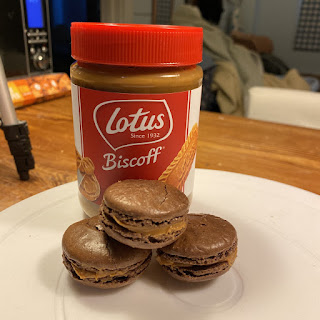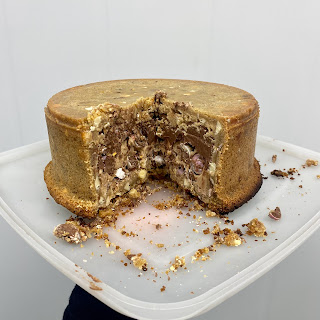Biscoff Macarons
This spread is probably one of the most addictive foods I've ever experienced... I blame my Mum as she went through a phase of stockpiling the stuff when it first came out. After trying to think of everything I could do with it (the dirty minded ones of you, keep it shut) I've actually developed a list of bakes I'd like to make in the weeks to come.
First came the fudge and now it's the turn of the Macaron. With a basic chocolate shell, these little patisserie delights are stuffed with the good stuff.
Ingredients
For the macarons:
- 120g ground almond
- 25g cocoa powder
- 200g icing sugar
- 100g egg whites
- 30g granulated or caster sugar
- Biscoff spread (half a jar for the macarons and half for you whilst filling them)
Method
- Begin by blitzing the ground almond, cocoa and the icing sugar in a food processor until a finer crumb is achieved. Sieve this mixture into a medium sized bowl to remove any larger pieces of almond. Place this to the side for now.
- In a second bowl, whisk your egg whites until they begin to form soft peaks. Now, slowly add in the caster a little bit at a time until stronger peaks are formed and the appearance is a lot shinier.
- Sieve the almond, cocoa and icing sugar mixture into the egg whites to again remove any larger pieces of almond. Following a clockwise motion with your spatula, cut the mixture down the middle and then fold to the right; take it slow as overworking the mixture can prevent the macarons from rising properly. Continue this motion until you are able to draw a FULL figure of 8 before the mixture dissolves back into itself. Once you can do this, the mixture is ready. DO NOT fold anymore.
- Transfer the mixture to a piping bag and put to the side. Line a baking tray with non-stick paper and then draw round a circular biscuit cutter until the tray is full of circles ensuring they're an inch apart! This allows the macaron mixture to spread whilst resting!
- Pipe the macarons onto the baking tray, tap multiple times on the counter to burst bubbles in the mixture as this can prevent them from rising properly. Leave the macarons to rest for approximately half an hour until you can touch them on the top without getting any mixture on your finger.
- Once they have rested, place them in an oven set to 150C for 20-25 minutes. To check they are done, remove one from the tray; if it doesn't stick, they're done!
- Once done, allow to rest for 15 minutes before then choosing two halves close in size and filling with as much Biscoff Spread as you'd like; the more the better in my opinion!
- Make a cuppa, kick your legs up and enjoy this little moment of joy.
Find me on Youtube:



If the texture is on a floor that is perpendicular or angled away from the mould opening, then no draft changes are needed. If the texture is on a parallel floor with the mould opening, however, increased draft is necessary to stop scraping and drag marks that would occur throughout part ejection. The rule-of-thumb when designing for texture is to have 1.5 degrees of draft for every zero.001" of texture end depth. Discoloration, or “color streaking”, occurs when a molded part is a different colour than meant. best gel pens for coloring Often the discoloration is limited to a localized space or a number of} streaks of irregular colour on a molded part. This defect usually affects the looks of the part with out decreasing its energy.
ReplyDelete